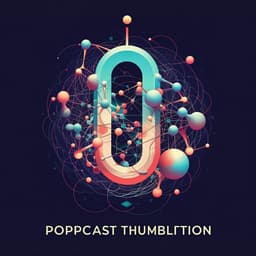
Physics
Quantum advantage in postselected metrology
D. R. M. Arvidsson-shukur, N. Y. Halpern, et al.
Explore the groundbreaking research by David R. M. Arvidsson-Shukur, Nicole Yunger Halpern, Hugo V. Lepage, Aleksander A. Lasek, Crispin H. W. Barnes, and Seth Lloyd. Their work reveals how postselection can dramatically enhance Fisher information in parameter-estimation experiments, leveraging negative quasiprobabilities to achieve remarkable information-cost rates unattainable by classical theories.
Playback language: English
Introduction
The advancement of quantum technologies hinges on a deeper understanding of quantum phenomena and their nonclassicality. This paper investigates nonclassicality through the lens of noncommutation, quantifying it using the negativity of quasiprobability distributions—quantum extensions of classical probability distributions. Unlike classical probabilities (real and nonnegative), quasiprobabilities can be negative or nonreal, reflecting the non-commutativity of quantum observables. The Kirkwood-Dirac quasiprobability distribution is employed, signaling nonclassical noncommutation via negative or nonreal values.
Quantum metrology, the estimation of unknown parameters using quantum phenomena, serves as the application domain. The paper explores whether postselection, a technique of choosing a subset of experimental outcomes, can provide a nonclassical advantage in general quantum parameter estimation. This builds upon previous studies of postselection's impact on classical and quantum experiments, particularly concerning weak values and their metrological advantages in estimating weak-coupling strengths. The study differs by addressing general quantum parameter-estimation experiments beyond the weak-coupling setting, examining whether postselection provides a general nonclassical advantage. The primary aim is to determine if postselection can enhance information-cost rates in a way fundamentally impossible classically, thus proving a quantum advantage.
Literature Review
The paper reviews existing literature on quantum metrology, focusing on the use of entanglement to enhance parameter estimation beyond classical limits. It cites works that have explored the use of entanglement in improving error scaling from N⁻¹/² to N⁻¹. It also reviews previous work on postselection in both classical and quantum settings, highlighting the ongoing debate surrounding the ontological nature of postselected quantum states and their nonclassical behavior. The literature on weak values and their applications in metrology is discussed, pointing to the metrological advantages observed in the estimation of weak-coupling strengths. This review sets the stage for the paper's central question: Can postselection provide a nonclassical advantage in general quantum parameter-estimation experiments?
Methodology
The paper compares two types of metrological procedures: optimized prepare-measure experiments and postselected prepare-measure experiments. In the former, the input system and measurement are optimized to maximize the Fisher information. In the latter, a postselection measurement is performed before an information-optimized final measurement. The quantum Fisher information is used as a key metric. For a pure state, it's expressed as 4Var(Â), where  is a Hermitian operator representing the unknown transformation. The paper derives an expression for the quantum Fisher information in a postselected experiment using the renormalized quantum state after postselection.
Crucially, the paper introduces a doubly extended Kirkwood-Dirac quasiprobability distribution to represent the quantum state. This distribution is defined in terms of eigenbases of the Hermitian operator  (governing the unknown transformation) and the postselection operator F. The choice of this distribution is justified by its suitability for mathematically expressing and analyzing the postselected quantum Fisher information. The standard Kirkwood-Dirac distribution is extended to allow for a more concise and physically meaningful expression for the Fisher information in the postselected scenario.
The paper then proves two key theorems: Theorem 1 establishes that in a classical (commuting) theory, postselection cannot surpass the Fisher information achievable with an optimized prepare-measure experiment. Theorem 2 demonstrates that anomalous postselected Fisher information (exceeding the classical bound) implies that the quantum Fisher information cannot be represented by a nonnegative doubly extended Kirkwood-Dirac quasiprobability distribution, thus requiring non-commutativity.
The relationship between the doubly extended Kirkwood-Dirac quasiprobability distribution and the standard Kirkwood-Dirac distribution is explored, connecting negative quasiprobabilities to negative or nonreal weak values, which are indicative of quantum contextuality. The paper also considers the impact of experimental costs (preparation, postselection, measurement) on the information-cost rate (Fisher information per cost) and demonstrates that postselection can improve this rate in quantum experiments. Supplementary notes provide detailed proofs and further experimental examples.
Key Findings
The key findings of the paper revolve around the demonstration of a quantum advantage in metrology using postselection. The paper establishes that postselection can enhance the Fisher information beyond the limits achievable in classical and even in optimized quantum prepare-measure experiments. This advantage is inextricably linked to the non-commutativity of quantum mechanics, specifically manifesting as negativity in the doubly extended Kirkwood-Dirac quasiprobability distribution.
The paper proves two critical theorems: Theorem 1 demonstrates that in a classical (commuting) system, postselection cannot increase the Fisher information beyond what is attainable via optimized input and measurement. This establishes a baseline against which the quantum advantage is measured. Theorem 2 proves the converse: Anomalous postselected Fisher information (exceeding the classical bound) necessarily implies the presence of non-commutativity and hence a nonclassical effect.
The paper quantitatively links this nonclassical advantage to the negativity of the quasiprobability distribution. The authors show that the presence of negative values in this distribution enables the postselected experiments to surpass the classical information-cost rates. The study shows that even when considering experimental costs (state preparation, postselection, and measurement), postselection can improve the information-cost rate beyond the limits possible classically. Further, it is demonstrated that under specific conditions, the postselected Fisher information can grow arbitrarily large, indicating a potentially unbounded quantum advantage in certain metrological scenarios.
Discussion
The findings of this paper significantly contribute to our understanding of quantum metrology and the fundamental nature of quantum mechanics. The demonstration of a nonclassical metrological advantage using postselection establishes a new avenue for enhancing parameter estimation beyond classical limits. The use of quasiprobability distributions and their inherent negativity provides a concrete mathematical framework for understanding this advantage, directly linking it to the noncommutativity of quantum observables. The results extend previous work on weak values by demonstrating a general quantum advantage in arbitrary quantum parameter-estimation experiments, not just limited to weak measurements.
The inclusion of experimental costs in the analysis provides a more realistic assessment of the practical implications of postselection in metrology. The potential for unbounded Fisher information under specific conditions highlights the profound implications of quantum noncommutativity in enabling significantly superior metrological performance. This work paves the way for the development of new quantum metrology protocols that leverage postselection for improved accuracy and efficiency.
Conclusion
This paper demonstrates a quantum advantage in metrology achievable through postselection, directly linked to the noncommutativity of quantum mechanics and manifested as negativity in a quasiprobability distribution. This advantage transcends limitations of classical and even optimized quantum prepare-measure experiments, extending beyond previous weak-value results to encompass general parameter estimation. Future research could explore specific experimental implementations and broader applications of this quantum advantage in various metrological contexts.
Limitations
The theoretical analysis presented focuses primarily on idealized scenarios. Real-world implementations may encounter imperfections such as noise and decoherence, which could impact the achievable quantum advantage. Further research is needed to investigate the robustness of these findings to realistic experimental conditions. The focus on projective postselection leaves open the investigation of more general types of postselection and their effects on the information-cost rate.
Related Publications
Explore these studies to deepen your understanding of the subject.







